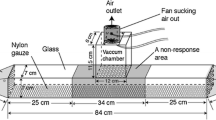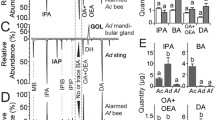Abstract
Bees of the genusTrigona and subgenusTrigona possess volatile materials in their mandibular glands, used as alarm substances and as marking pheromones. Heads of workers ofTrigona fulviventris were analyzed by gas chromatography-mass spectrometry. The two major volatile components were nerol (∼ 50%), and octyl caproate (∼ 20%). Relative to other substances tested at a Costa Rican nest, treatments containing 20 μg of nerol attractedT. fulviventris, depressed numbers of bees leaving the nest by about 50%, and elicited wing vibration and biting. The responses were similar to those obtained with the contents of one worker head. Attraction and biting were also seen in response to captures of colony members by assassin bugs (Apiomerus pictipes) outside a nest entrance; one bee responded in about 15% of the captures. This alarm behavior, although weak, is of interest since it was thought thatT. fulviventris was unusual for its subgenus in its lack of nest defense behaviors.
Similar content being viewed by others
References
Baroni Urbani, C. 1979. Territoriality in social insects, pp. 91–120,in H.R. Hermann (ed.). Social Insects. Academic Press, New York.
Blum, M.S. 1966. Chemical releasers of social behavior. VIII. Citral in the mandibular gland secretion ofLestrimelitta limao.Ann. Entomol. Soc. Am. 59:962–964.
Blum, M.S. 1970. The chemical basis of insect sociality, pp. 61–94,in M. Beroza (ed.). Chemicals Controlling Insect Behavior. Academic Press, New York.
Blum, M.S., andBrand, J.M. 1972. Social insect pheromones: Their chemistry and function.Am. Zool. 12:553–576.
Blum, M.S., Crewe, R.M., Kerr, W.E., Keith, L.H., Garrison, A.W., andWalker, M.M. 1970. Citral in stingless bees: Isolation and functions in trail-laying and robbing.J. Insect Physiol 16:1637–1648.
Collins, A.M., Rinderer, T.E., Tucker, K.W., Sylvester, H.A., andLackett, J.J. 1980. A model of honeybee defensive behaviour.J. Apic. Res. 19:224–231.
Darchen, R. 1966. Sur l'éthologie deTrigona (Dactylurina)staudingeri.Biol. Gabonica 2:37–45.
Hertz, M. 1930. Die Organisation des optischen Feldes bei der Biene, II.Z. Vergl. Physiol. 11:107–145.
Hertz, M. 1935. Zur Physiologie des Formen- und Bewegungssehens. III. Figurale Unterscheidung und reziproke Dressuren bei der Biene.Z. Vergl. Physiol. 21:604–615.
Hubbell, S. P., andJohnson, L. K. 1977. Competition and nest spacing in a tropical stingless bee community.Ecology 58:949–963.
Hubbell, S.P., andJohnson, L.K. 1978. Comparative foraging behavior of six stingless bee species exploiting a standardized resource.Ecology 59:1123–1136.
Jacobs-Jessen, U.F. 1959. Zur Orientierung der Hummeln und einiger anderer Hymenopteren.Z. Vergl. Physiol. 41:597–641.
Johnson, L.K. 1974. The role of agonistic behavior in the foraging strategies ofTrigona bees. Doctoral thesis, University of California, Berkeley.
Johnson, L.K. 1980. Alarm response of foragingTrigona fulviventris (Hymenoptera: Apidae) to mandibular gland components of competing bee species.J. Kans. Entomol. Soc. 53:357–362.
Johnson, L. K. 1982a. Foraging strategies and the structure of stingless bee communities in Costa Rica,in P. Jaisson (ed.). Social Insects in the Tropics. In press.
Johnson, L.K. 1982b. The costly extermination of aTrigona fulviventris colony by nest-robbing bees.Biotropica. In press.
Kerr, W.E., andde Lello, E. 1962. Sting glands in stingless bees—a vestigial character.J. N. Y. Entomol. Soc. 70:190–214.
Koeniger, N. 1975. Observations on alarm behavior and colony defense ofApis dorsata. Proc. Symp. I.U.S.S.I., Dijon, 1975, pp. 153–154.
Leuthold, R.H., andSchlunegger, U. 1973. The alarm behaviour from the mandibular gland secretion in the antCrematogaster scutellaris.Insectes Soc. 20:205–214.
Luby, J.M., Regnier, F.E., Clarke, E.T., Weaver, E.C., andWeaver, N. 1973. Volatile cephalic substances of the stingless bees,Trigona mexicana andTrigona pectoralis. J. Insect Physiol. 19:1111–1127.
Michener, C.D. 1946. Notes on the habits of some Panamanian stingless bees.J. N. Y. Entomol. Soc. 54:179–197.
Michener, C.D. 1974. The Social Behavior of the Bees. Belknap Press, Cambridge, Massachusetts.
Moser, J.C., Brownlee, R.C., andSilverstein, R. 1968. Alarm pheromones of the antAtta texana.J. Insect Physiol. 14:529–535.
Nogueira-Neto, P. 1970. Behavior problems related to the pillages made by some parasitic stingless bees (Meliponinae, Apidae), pp. 416–434,in L.R. Aronson, E. Tobach, D.S. Lehrman, and J.S. Rosenblatt, (eds.). Development and Evolution of Behavior, Essays in Memory of T.C. Schneirla, Freeman, San Francisco.
Pickett, J.A., Williams, I.H., Martin, A.P., andSmith, M.C. 1980. Nasonov pheromone of the honey bee,Apis mellifera L. (Hymenoptera: Apidae) Part I. Chemical characterization.J. Chem. Ecol. 6:425–434.
Rau, P. 1933. The Jungle Bees and Wasps of Barro Colorado Island. Van Hoffman Press, St. Louis, Missouri.
Sakagami, S., andAkahira, Y. 1959. Studies on the Japanese honeybee,Apis cerana cerana Fabricius. VIII. Two opposing adaptations in the post-stinging behavior of honeybees.Evolution 14:29–40.
Schwarz, H.F. 1948. Stingless bees (Meliponidae) of the Western Hemisphere.Bull. Am. Mus. Nat. Hist. 90:1–546.
Shearer, D.A., andBoch, R. 1966. Citralin the Nassanoff pheromone of the honeybee.J. Insect Physiol. 12:1513–1521.
Smith, B.H. andRoubik, D.W. 1982. Skatole and 2-heptanol as alarm pheromones in two species ofMelipona (Hymenoptera: Apidae). Unpublished manuscript.
Weaver, E.C., Clarke, E.T., andWeaver, N. 1975a. Attractiveness of an assassin bug to stingless bees.J. Kans. Entomol. Soc. 48:17–18.
Weaver, N., Weaver, E.C., andClarke, E.T. 1975b. Reactions of five species of stingless bees to some volatile chemicals and to other species of bees.J. Insect Physiol. 21:479–494.
Wille, A. 1965. Las abejas attará de la región mesoamericana del género y subgéneroTrigona (Apidae-Meliponini).Rev. Biol. Trop. 13:271–291.
Wille, A., andMichener, C.D. 1973. The nest architecture of stingless bees with special reference to those of Costa Rica.Rev. Biol. Trop. 21(Supl. 1): 1–278.
Wilson, E.O. 1971. The Insect Societies. Belknap Press, Cambridge, Massachusetts.
Wilson, E.O., andBossert, W.H. 1963. Chemical communication among animals.Recent Prog. Horm. Res. 19:673–716.
Author information
Authors and Affiliations
Rights and permissions
About this article
Cite this article
Johnson, L.K., Wiemer, D.F. Nerol: An alarm substance of the stingless bee,Trigona fulviventris (Hymenoptera: Apidae). J Chem Ecol 8, 1167–1181 (1982). https://doi.org/10.1007/BF00990750
Received:
Revised:
Issue Date:
DOI: https://doi.org/10.1007/BF00990750




